
PREV ARTICLE
NEXT ARTICLE
FULL ISSUE
PREV FULL ISSUE
WAYNE'S NUMISMATIC DIARY: JULY 17, 2016The months roll by fast. Tuesday July 12, 2016 was the meeting night of my northern Virginia numismatic social group, Nummis Nova. The night's host was Mike Packard, and he picked Four Sisters, a Vietnamese restaurant in Falls Church. I arrived early and won a hard-fought parking space in the building's garage. I was the first to enter the restaurant, but when I turned around to grab a seat at the bar, Eric Schena was right behind me and we took our seats while we waited for them to set up our table for dinner. We lamented that Howard Daniel couldn't be with us. He lives half the year in Viet Nam, and might have helped with the menu. I lamented that our resident wine expert Gene Brandenburg wasn't with us yet. But I asked myself "What would Gene do?" and ordered a glass of Malbec from Argentina. Christensen and Stone

Eric brought with him a set of Christensen & Stone mail bid sale catalogs. These two lady dealers from California (Alva Christensen and Ethel R. Stone) were active from the mid-1960s thru the early 70s, often selling medals. He was lending the set to me for the Newman Numismatic Portal. It will be a great complement to the medal literature already digitized, including the Presidential Coin and Antique sales from Joe Levine, and the MCA Advisory from the Medal Collectors of America. Joe Esposito was the third to arrive and soon after we spotted Gene walking on the sidewalk outside. We were told our table was ready, and migrated to the dining room. Dave Schenkman was next, having dropped off Gene and gone to park his car. Dave sat to my left. Going around the table, other attendees Tuesday were Wayne Herndon, Steve Bishop, Julian Leidman, Joe Levine, Tom Kays, Mike Packard, and Ron Abler. Spent By A Lawful Gun Owner
Am I Not A Man and a Centurian?
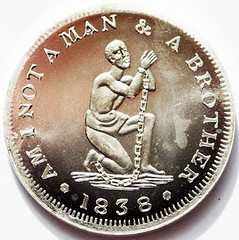 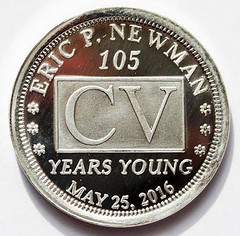
Images courtesy Dave Schenkman The other item I brought was a silver medal made by Stu Levine in honor of our friend Eric P. Newman's 105th birthday. The "CV" of course, is 105 in Roman numerals. Coincidentally, my son told me this joke at home that night: "A Roman walks into bar, holds up two fingers and says, 'Five beers, please'" The medal's obverse design is modeled after the famous anti-slavery Hard Times Token, one of Eric's favorites. 2015 Palau Treasure of the Cruel Captain $5
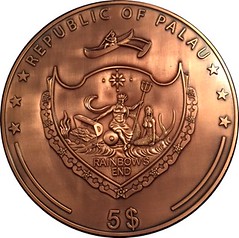 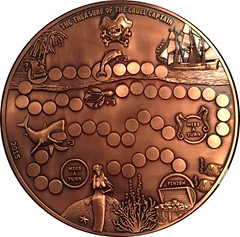
Images courtesy Tom Kays I did NOT expect to see this at our meeting. Joe Esposito brought along this giant $5 "coin" from Palau. See my photo below for an appreciation of its size. Joe writes: An increasing number of unusual coins identified with the Republic of Palau, a small archipelago nation in the western Pacific, have been released over the past decade. They include ones with a colorful natural history or architectural history theme, marine life (even one with an embedded pearl), and a sliver of emerald, sapphire, ruby or amethyst. There also is a unique biblical series. Most of these are 39-mm silver proof coins. This high-relief 2015 coin, also unusual, is different: The diameter is 180 mm and it weighs a hefty 680 grams. Composed of an antiqued copper-zinc alloy, it is legal tender and denominated at $5. Palau uses U.S. currency, but it is highly unlikely that you would use this massive coin for a commercial transaction. In addition to its amusing, commemorative character, this coin has a game on the reverse, “The Treasure of the Cruel Captain.” Although simple enough, using dice and markers, the two-player game is fun to play. It has a black, velvet-like pouch for easy transport. The coin is identified as being “authorized by Palau Commemorative Coin Company.” It comes with a Certificate of Authenticity! 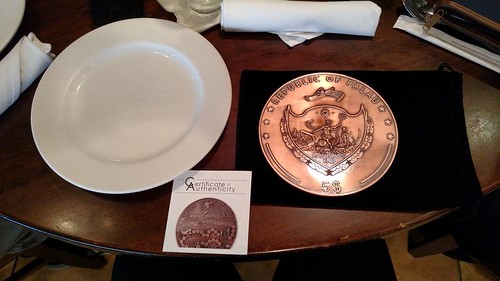
WWI German POW Trench Art Jewelry
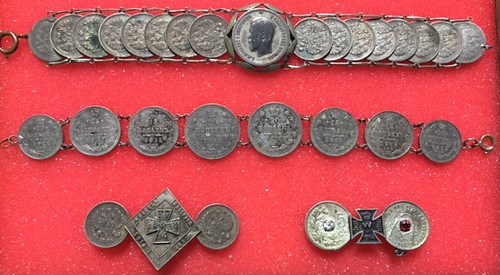
Tom Kays exhibited some interesting coin jewelery. He writes: "The story on my contribution of the WWI German POW jewelry made of Russian and Belgian coins, (Quotes from website: Trench Art of the Great War and Related Souvenirs by Jane A Kimball)." “Trench art were made by soldiers, civilians, and prisoners of war during the Great War and afterwards. Trench art finger rings were produced in quantity from brass, aluminum, or silver coins. Regimental badges were made into pins and lockets, often called ‘sweetheart jewelry’ by soldiers and commercial firms to strengthen the bond between soldiers at the front and their loved ones at home. "Prisoners of war on both sides produced an amazing variety of artifacts made for sale to soldiers or civilians in areas near camps in which they were interned. Some camps held artistic exhibitions in which these handicrafts were offered for sale to the public. Most are not signed.” These examples, some with patriotic “Iron Cross” and with German abbreviations for “War Remembrance” were made by German POWs of pre-1917 Russian coins, plus one of Belgian coins with inset stones. “Iron crosses were a popular motif for both allied and German trench artists. Thousands of pieces of trench art souvenirs brought home by soldiers and by tourists visiting battlefields after the war eventually drifted up to the attic or down to the basement as memories of the war faded. Many of the larger brass pieces were destroyed in WWII scrap metal drives. "Unlike other collectibles, trench art does not significantly suffer from modern reproductions due to the extensive hand labor to make the items in the first place. Every piece of trench art is a unique artistic creation. This art form, born of blood and sacrifice, deserves much more attention than it has received to date.“ The 100th year anniversary of the Battle of the Somme brought these to my attention and I thought to share these newly matured “antiques” with you. 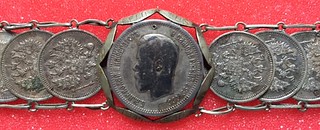
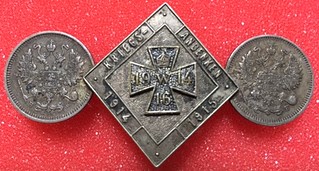
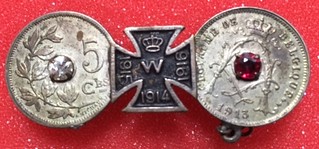
To visit the Trench Art web site, see:
San Francisco Assaying & Refining Works Cambist
Eric writes: I brought a nice copy of the San Francisco Assaying & Refining Works' Gold and Silver Tables Showing the Value per Ounce Troy, At Different Degrees of Fineness, and the Net Returns of Gold and Silver when Refined, also, Other Useful Tables Applicable to the Business of the Pacific Coast, printed in 1867 by Towne & Bacon’s Excelsior Book and Job Printing Establishment, 536 Clay St., San Francisco. I have been fascinated in Gold Rush material for as long as I have been a coin collector (the private and territorial section of the Red Book was always my favorite as a kid) and have a very small collection of related ephemera. In April 1855, John Glover Kellogg and Augustus Humbert established the assaying firm of Kellogg & Humbert at 106 Montgomery St. in San Francisco. Known today for the large number of ingots found on the S. S. Central America, Kellogg & Humbert also produced $20 gold coins under the Kellogg & Co. name in 1854 and 1855 to fill the immediate need for coins until the new San Francisco Mint could begin production in earnest. At some point, the firm moved to a larger location at 416 Montgomery St. where it would remain. The firm dissolved in 1860 following Humbert’s retirement from the assaying business. Kellogg then formed a partnership with another assayer, John Hewston, Jr. to form Kellogg, Hewston & Co. Kellogg, Hewston & Co. continued until 1866 when Kellogg retired. The successor firm, the San Francisco Assaying & Refining Works, continued in business until 1875 when the Bank of California failed as a result of the Panic of 1873, when it closed and came into the possession of the Selby Lead & Silver Smelting Company. The book of tables allowed for quick valuation of gold and silver per troy ounce based on assayed fineness of the metal. This, as well as a trio of bullion receipts by Kellogg & Humbert, Kellogg, Hewston & Co., and the San Francisco Assaying & Refining Works, are about as close as I will ever get to owning one of those magnificent Gold Rush ingots. Gold Mountain Mining Scrip

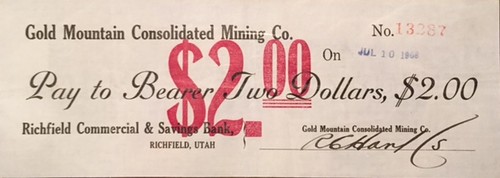
Images courtesy Tom Kays Eric Schena writes: The Gold Mountain Consolidated Mining Company $1 and $2 notes are neat examples of Panic of 1907 mining scrip. The effects of the Panic of 1907 were felt nationwide, including to the more remote mining districts in the American West. The Gold Mountain Consolidated Mining Company operated at the turn of the century in Piute County, Utah as well as at least two mines in Nevada. The notes were issued in late 1907 but were payable on July 10, 1908. Richfield is the county seat of neighboring Sevier County and is the largest community in the area, hence the account's location at the Richfield Commercial & Savings Bank. Of Cabbages and Kings, Admirals and Banjos
I also quizzed Gene Brandenburg (who was drinking beer, by the way), showing him my wine glass and asking if he could predict what I'd ordered sans his usual help. He looked over the wine list and and said, "the Malbec from Argentina." I think I was the one who passed the test. I forget how we got onto the topic of famous people we'd met, but some of us at least, are a nerdly bunch. Ron Abler told us he was on a lecture tour with "the woman who coined the the term "bug" for a computer glitch. "Grace Hopper?", I asked, to the blank stares of those around us. Grace Hopper was one of the first computer programmers of the modern era, rising to the rank of Admiral in the U.S. Navy. Ron had been in charge of rolling out the first shipments of personal computers in the Dept. of Defense, and he and Hopper were speaking about their experiences at government conferences around the country. She was in her 80s at the time. My own nerdly brushes with fame include Internet pioneer Vinton Cerf and the man who invented the emoticon, those character-based forerunners of emoji indicating emotion in email. It was Scott Falhman, a red-headed leprechaun of a professor at Carnegie-Mellon University (look it up on Wikipedia). 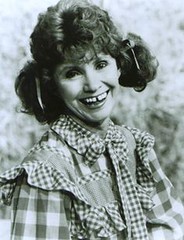 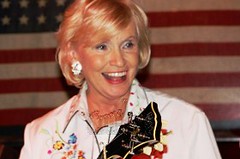
But proving that banjo players are way cooler than computer geeks, I think Dave Schenkman topped us all with his tales of playing with Hee Haw star performer and "First Lady of the Banjo", Roni Stoneman. It was a great evening, as usual. I'm already looking forward to next month, when our post-ANA convention dinner will be hosted by Julian Leidman. To read the earlier E-Sylum article, see: EXHIBIT: NEW IDEAS IN MEDALLIC SCULPTURE (www.coinbooks.org/esylum_v19n28a25.html) 
Wayne Homren, Editor The Numismatic Bibliomania Society is a non-profit organization promoting numismatic literature. See our web site at coinbooks.org. To submit items for publication in The E-Sylum, write to the Editor at this address: whomren@gmail.com To subscribe go to: https://my.binhost.com/lists/listinfo/esylum All Rights Reserved. NBS Home Page Contact the NBS webmaster 
|
